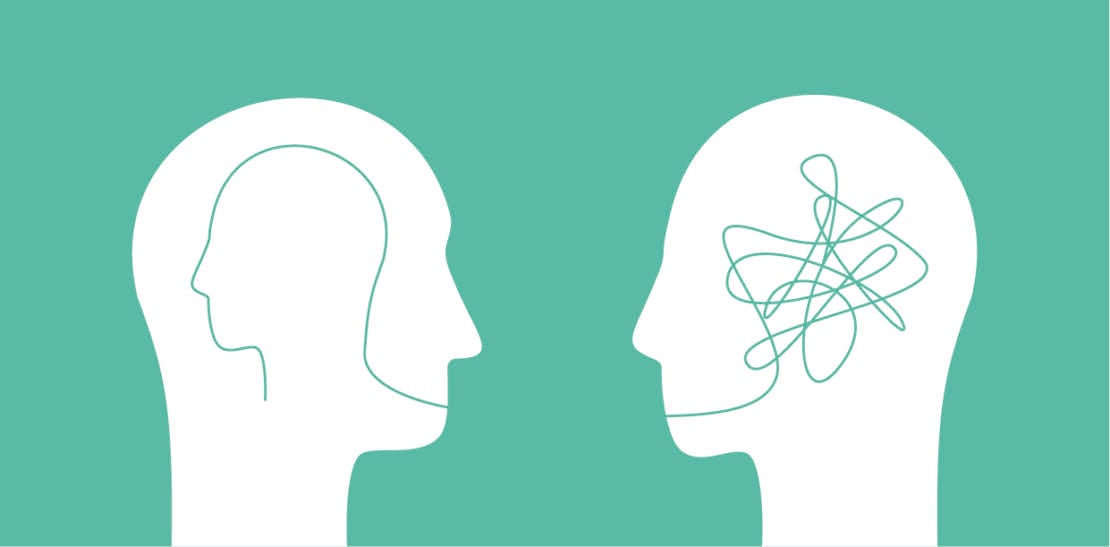
Empathy vs sympathy in design
July 2021
By Francesca Stephens – Product Designer and Sustainability Insights Lead at 42 Technology

Recently, I had the opportunity to receive Mental Health First Aider training. During the course, the tutor played this video of the influential author, Dr Brené Brown, discussing empathy:
In it, Dr Brown reminds us of the difference between empathy and sympathy when easing someone’s pain and suffering. She notes that nursing scholar, Theresa Wiseman, came up with four qualities for empathy:
- Perspective taking – understanding that we all make sense of the world differently and that because of this, our feelings, beliefs, and behaviours are unique. We should never expect someone else to have the same reaction to a situation as we do.
- Staying out of judgement – we tend to instantly judge, and most of the time that judgement is unconscious. Stepping back, thinking about the other person’s perspective, can help you ignore your instant judgements.
- Recognising emotion in other people – it might be that a person is not visibly upset making it harder to read them. But noticing a change in their behaviour or attitude may tell you something isn’t right.
- Communicating that emotion – “Rarely does an empathetic response begin with “at least…”. By sympathising we recognise the emotion, but we try to make the person feel better by silver lining the problem. Sometimes the best thing to say is nothing at all, and just let them know you’re there.
Watching the video made me think about how we approach user problems in design. When is a design sympathetic and when is it empathetic?
"Empathy drives connection, sympathy drives disconnection"*
Empathetic design requires considerable effort by designers. And there are common research techniques for empathising with real users throughout the development process. Ms Wiseman’s four qualities can be used to describe these techniques:
Perspective taking
"Empathy is feeling with people".
Based on our perspective, what we believe is the problem might be different to someone else’s. So designers need to go see, talk to, and understand users. When conducting initial research, designers must watch users use the intended products, observe any difficulties and talk to them about the product. This method of initial exploration with the user is commonly called ethnographic research and is regularly used in user-centred design.
"In order to connect with you, I have to connect with something in myself that knows that feeling".
A designer can get perspective of what it’s like to be the user by literally being the user. I have seen designers restrict themselves physically to understand how certain users get by in a normal day. For instance, using public transport or tasks we take for granted like opening doors or reading a book. By simply using the intended product in situ, and with the user in mind, you can tell a lot about the difficulties the user faces.
Staying out of judgement
Interviewing or simply asking questions in conversation with a user can get a lot of information quickly. But there’s an art to user interviews. Bias from the interviewer can change a user’s opinion or at worst, influence the user to adopt a position which they believe the interviewer wants to hear, rather than their genuine view. To empathise with the user, interviews need to be one sided on the user’s part.
"Rarely a response makes something better…"
Listening is important. Think of a therapist, just saying “why?” when the patient stops talking. You could say that’s the attitude designers should adopt in user interviews.
Recognising emotion in other people
"I’m stuck, it’s dark, I’m overwhelmed".
Users don’t always tell you directly that they have a problem. They can get frustrated with a design, forget or blame themselves about that frustration and regularly pass it off as an everyday issue. Commonly, they don’t want to offend the designer or brand they are working with, so you might not get everything you need from just talking to them or reading surveys. This is when observing from a distance is a helpful technique. Letting them use products for the first time without instruction, and letting them show their frustration, can tell you a lot about the design.
Communicating that emotion
"…what makes something better is connection".
The essence of user-centred and inclusive design is making people’s lives better through design. Designers must be aware of this throughout the design process and be unbiased with themselves and the users when they present their ideas, designs or prototypes. Taking the users through the process will mean they feel involved and want to contribute.
"Ooh, it’s bad uh-huh?!"
Sympathetic design is conducting the design process having only made assumptions of the user. To have sympathy is effortless. If a designer sympathises with their product user, they are just acknowledging there’s a problem. The solution to that problem is then assumed, which creates a final product that, usually, the user will dislike.
Unfortunately, this is common and often there isn’t budget or time for designers to find, carry out or develop user relationships. But there is a lot designers can do on a tight budget to connect with users.
Surveys & online forums
A simple survey that can be shared online can gain quick and valuable data. To get that extra connection with users, designers can post a question on an internet forum. This can be hit or miss, but worth a try for the time it takes to do.
Colleagues, friends & family
Product dependent, it may be that the user problem you are investigating is close to home. Asking the people around you in casual conversation on your area of research may give you a good insight into their issues.
Existing research
Companies may have consumer insights data that has been collected previously - this is common in large consumer companies. It may not be as personal as visiting real users but will convey some key insights.
Online tools
There are several online tools and databases to help with universal, inclusive, and ergonomic design. The University of Cambridge has an inclusive design toolkit which includes exclusion calculators and personas to help the design process.
Impairment tools
Tools to enhance impairment can be bought or be made. Weights can be placed on ankles, chest and wrists to reduce mobility and blindfolds can simulate blindness. The inclusive design toolkit offers glasses to simulate visual impairment and gloves to simulate reduced dexterity.
These tools are valuable but they’re a compromise. The continuous relationship with users is missed. Being able to return to users with your prototype designs and troubleshoot them is time well spent. However, making an effort to make that connection - in the design process or with someone’s mental health - no matter how small, makes a large improvement.
At 42 Technology, we are passionate about user-centred design, and we know that user acceptance is key for the success of a product. With user insights, as with technical information, we want to know the facts before generating ideas. We regularly use ethnographic research and the tools mentioned above to understand and empathise with our users in our projects.
*All quotes are taken from the video Brené Brown on Empathy on the Royal Society of Arts (RSA) YouTube channel - an extract from Dr Brown’s talk on The Power of Vulnerability at the RSA in 2013.

If you would like to find out more, please contact Francesca:
francesca.stephens@42T.com | +44 (0)1480 302700 | www.linkedin.com/in/fastephens
Francesca graduated with first class honours Masters in Product Design Engineering from Glasgow School of Art. She is a passionate, creative and logical thinking product designer with experience in concept generation, visualisation, CAD, inclusive design and packaging design. She is circular design lead at 42 Technology in addition to having a keen focus on human factors.
Share this article:
Share this article:
Related Articles

Consumer, Sustainability
The refillable revolution - the sustainable future of grocery shopping

Sustainability, Industrial
The surge in the global Blue Economy - what role for deep tech?

Sustainability, Industrial
The hydrogen economy - solving difficult challenges towards energy transition

What will you ask us today?
We believe in asking the right questions to drive innovation; when we know the right questions, we generate the ideas to answer them.

